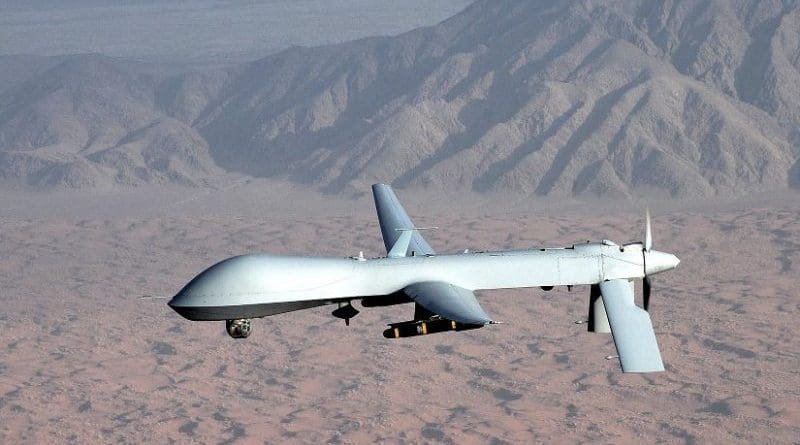US Controversy Continues Over Domestic Use Of Predator Drones – OpEd
By Jim Kouri
A small number of local police departments in the U.S. now use unmanned aerial vehicles (UAVs) after garnering federal approval, but once the Federal Aviation Administration promulgates new rules to open the skies to commercial use of unmanned aerial systems (UAS), that all will change, according to Daily Jeffersonian editorial yesterday.
Law enforcement agencies primarily use smaller versions of what many like to call Predator drones, which the military and CIA utilize in war zones. The non-military versions are used by local law enforcement for surveillance, search-and-rescue missions, to monitor traffic and even help with crowd control. While their use is now primarily for surveillance, there is concern that one day deadly weapons could be mounted onto domestic drones. However, non-lethal weaponry including rubber bullets, laser projectiles and tear gas is more likely should police agencies wish to use their UAS offensively.
Unmanned aerial systems appear to be all the rage within the law enforcement and military communities, especially since they do not carry a pilot on board, but instead operate on pre-programmed routes and by following commands from pilot-operated ground stations. But members of House of Representatives decided to investigate its uses — especially its domestic uses by federal, state and local law enforcement — as well as its impact on civil liberties, according to a Government Accountability Office report released on Sept. 14, 2012.
UAS can be small, generally 55 pounds or less, or large, such as unmanned helicopters. The GAO noted that current domestic uses include law enforcement, forest fire monitoring, border security, weather research, and scientific data collection. And while current uses are limited, that is likely to change under the Obama administration.
As the nation moves closer to sequestration — across-the-board budget cuts to the military, intelligence agencies and law enforcement departments — Unmanned Aerial Systems may become more and more useful in maintaining a certain degree of security, according to former police commander Charles Nettinger, now a security consultant.
“Two or three unmanned aerial vehicles will be able to monitor entire cities even during the darkest nights. If need be, weapons systems could be mounted on them, but that isn’t a desirable outcome,” Nettinger said.
The Federal Aviation Administration authorizes UAS use on a case-by-case basis after conducting a safety review. FAA and the other federal agencies that have a role or interest in UAS are working to provide routine access for UAS into the national airspace system, according to the 49-page GAO report.
Progress has been made, but additional work is needed to overcome many of the obstacles to the safe integration of UAS that the GAO first identified in 2008. At that time, the GAO analysts reported that “UAS could not meet the aviation safety requirements developed for manned aircraft and that this posed several obstacles to safe and routine operation in the national airspace system.”
The GAO analysts also noted: “These obstacles still exist and include the inability for UAS to sense and avoid other aircraft and airborne objects in a manner similar to manned aircraft; vulnerabilities in the command and control of UAS operations; the lack of technological and operational standards needed to guide safe and consistent performance of UAS; and final regulations to accelerate the safe integration of UAS into the national airspace system.”
The U.S. Congress set specific requirements and deadlines in its FAA Modernization and Reform Act of 2012 for FAA to safely accelerate UAS integration. FAA has begun making progress toward completing those requirements, but has missed one deadline and could miss others. Many of the requirements entail significant work, including completing planning efforts and issuing a final rule for small UAS. Most of the requirements are to be achieved by December 2015.
Concerns about privacy are far from being resolved and may influence acceptance of routine access for UAS in the national airspace system. The Department of Homeland Security’s Transportation Security Administration has the authority to regulate security of all modes of transportation, including non-military (local police, fire, border patrol, and emergency management) UAS.
Meanwhile, Americans’ privacy concerns include the potential for increased amounts of government surveillance using technologies placed on UAS, the collection and use of such data, and potential violations of constitutional Fourth Amendment protections against unreasonable search and seizures.
Currently, no federal agency has specific statutory responsibility to regulate privacy matters relating to UAS for the entire federal government. Some lawmakers believe that the Department of Homeland Security or the Department of Justice (DOJ) might be better positioned to address privacy issues since they generally stem from the operational uses of UAS for governmental surveillance and law enforcement purposes.
“However, many Americans may find the DHS and DOJ too politicized for such power and decision-making,” said police sergeant Stanley McLaughlin, who’s worked as a police aviation instructor.
“People — myself included — may be adverse to the use of ‘eyes in the sky’ being controlled by agencies that are engulfed in investigations into their alleged corruption or misconduct,” said McLaughlin.

